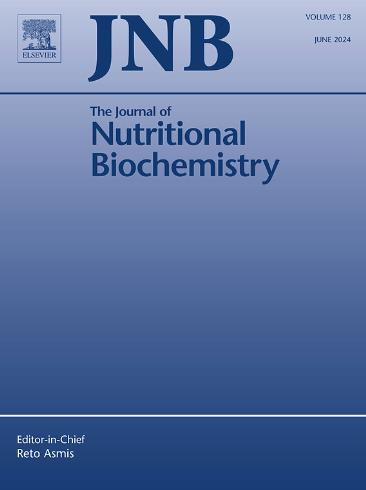鼠李糖乳杆菌GG对预防大鼠饮食性肥胖的作用:白色和棕色脂肪组织的含义和细菌活力的影响
IF 4.8
2区 医学
Q1 BIOCHEMISTRY & MOLECULAR BIOLOGY
引用次数: 0
摘要
肥胖是世界范围内最普遍的慢性代谢改变之一,与进一步相关合并症的风险增加高度相关。目前的证据表明,肥胖受试者具有明显的肠道微生物群特征,强调肠道微生物群组成是一个潜在的介导因素。本研究的目的是评估活菌和热灭活鼠李糖乳杆菌GG在预防大鼠饮食性肥胖模型中的潜在作用。益生菌或其热灭活后生物的施用以类似的方式部分阻止饮食引起的WAT增加。益生菌可降低脂质摄取(LPL)和新生脂肪生成(FAS),并增强WAT中的脂肪分解(ATGL),但其热灭活后的作用主要是减少新生脂肪生成。此外,所获得的结果表明,益生菌管理增强了BAT上的产热(UCP1)和脂肪酸氧化(CPT-1b),并上调了一些参与线粒体生物发生的标记(p38 MAPK, NRF1和CS)。相比之下,尽管以与益生菌类似的方式上调了生热作用和脂肪酸氧化作用,但这些结果并未伴随着线粒体生物发生标记物的变化。这些结果表明,在特定的实验条件下,给药活菌和热灭活鼠李糖乳杆菌GG对预防饮食诱导的大鼠WAT质量增加都具有重要的潜力。虽然两种处理对WAT和BAT的效果相似,但在涉及的作用机制中观察到可能源于细菌活力的细微差异。本文章由计算机程序翻译,如有差异,请以英文原文为准。

Effect of viable and inactivated Lactobacillus rhamnosus GG administration on the prevention of diet-induced obesity in rats: Implication of white and brown adipose tissue and influence of bacterial viability
Obesity is one of the most prevalent chronic metabolic alterations worldwide being highly related to an increased risk for further associated co-morbidities. Current evidence indicates that subjects with obesity have a distinct gut microbiota signature, emphasizing gut microbiota composition as a potential mediating factor. The aim of this research is to evaluate the potential effects of viable and heat-inactivated Lactobacillus rhamnosus GG in the prevention of diet-induced obesity in a rat model. The administration of the probiotic or its heat-inactivated postbiotic partially prevented diet-induced WAT increase in a similar manner. While viable probiotic administration resulted in a reduced lipid uptake (LPL) and de novo lipogenesis (FAS), along with enhanced lipolysis (ATGL) in WAT, its heat-inactivated postbiotic mainly acted reducing de novo lipogenesis. Additionally, the obtained results demonstrated that probiotic administration enhanced thermogenesis (UCP1) and fatty acid oxidation (CPT-1b) on BAT, as well as upregulated several markers involved in mitochondrial biogenesis (p38 MAPK, NRF1 and CS). By contrast, despite the administration of the postbiotic upregulated thermogenesis and fatty acid oxidation in a comparable manner as the probiotic, these results were not accompanied by changes in mitochondrial biogenesis markers. These results indicate that under the specific experimental conditions tested, both the administration of viable and heat-inactivated Lactobacillus rhamnosus GG present valuable potential for preventing diet-induced WAT mass increase in rats. While both treatments exerted similar effects on WAT and BAT, subtle differences that may derive from bacterial viability were observed in the involved mechanisms of action.
求助全文
通过发布文献求助,成功后即可免费获取论文全文。
去求助
来源期刊

Journal of Nutritional Biochemistry
医学-生化与分子生物学
CiteScore
9.50
自引率
3.60%
发文量
237
审稿时长
68 days
期刊介绍:
Devoted to advancements in nutritional sciences, The Journal of Nutritional Biochemistry presents experimental nutrition research as it relates to: biochemistry, molecular biology, toxicology, or physiology.
Rigorous reviews by an international editorial board of distinguished scientists ensure publication of the most current and key research being conducted in nutrition at the cellular, animal and human level. In addition to its monthly features of critical reviews and research articles, The Journal of Nutritional Biochemistry also periodically publishes emerging issues, experimental methods, and other types of articles.
 求助内容:
求助内容: 应助结果提醒方式:
应助结果提醒方式:


